A Critical Appraisal Report: Posters in Foreign Language Learning
VerifiedAdded on 2020/05/11
|17
|4515
|57
Report
AI Summary
This report presents a critical appraisal of the role of posters in foreign language learning. It examines five articles, evaluating the effectiveness of posters as visual aids in enhancing vocabulary, communication skills, and overall language acquisition. The report analyzes the research methodologies employed, highlighting both strengths and limitations. It also summarizes the advantages and disadvantages of using posters in language education, considering factors such as student engagement, creativity, and the potential for improved learning outcomes. The analysis concludes that posters can be an efficient tool for improving language skills, though their effectiveness may depend on the specific context and implementation strategies. The report emphasizes the importance of considering diverse visual aids and teaching methods to optimize the learning experience.
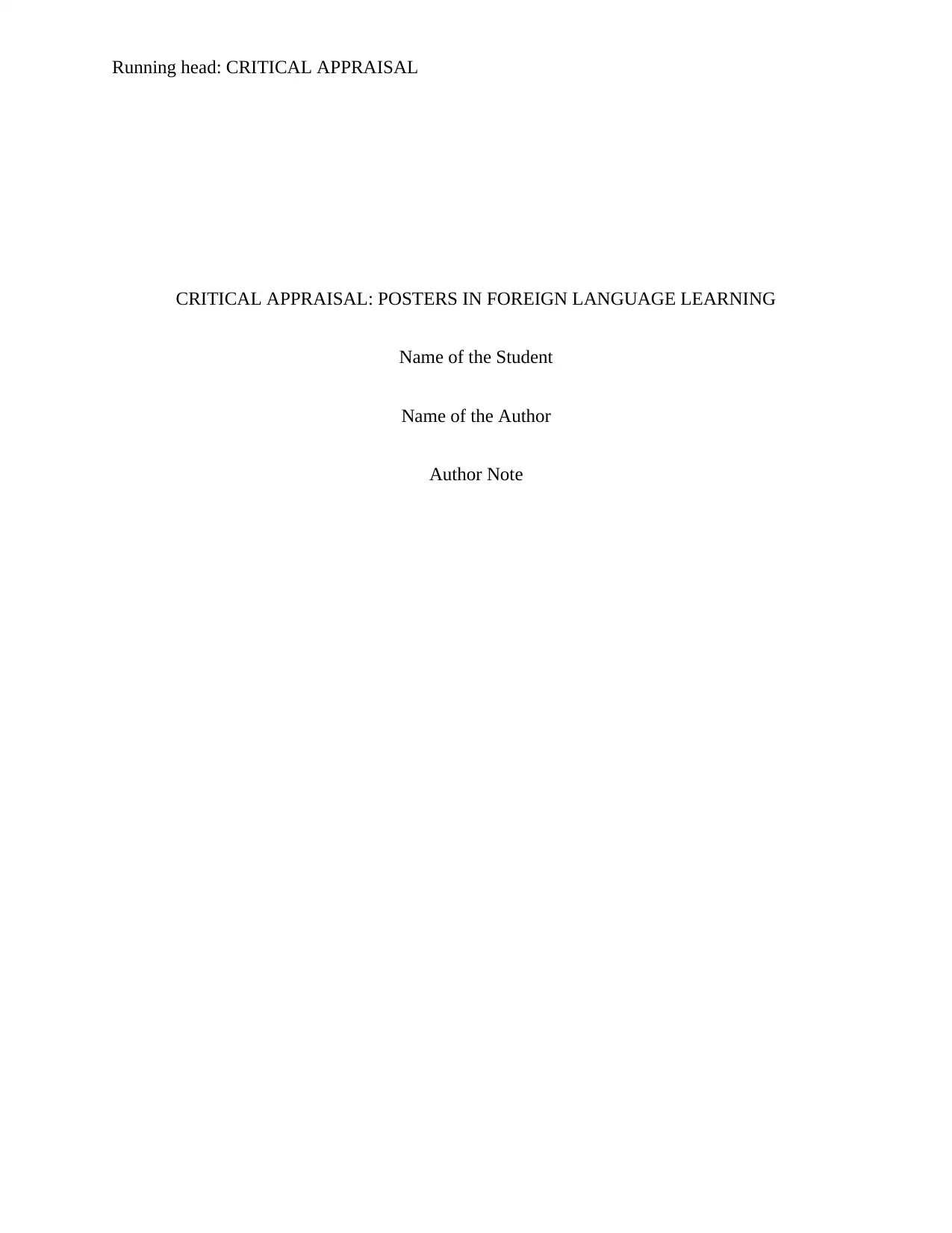
Running head: CRITICAL APPRAISAL
CRITICAL APPRAISAL: POSTERS IN FOREIGN LANGUAGE LEARNING
Name of the Student
Name of the Author
Author Note
CRITICAL APPRAISAL: POSTERS IN FOREIGN LANGUAGE LEARNING
Name of the Student
Name of the Author
Author Note
Paraphrase This Document
Need a fresh take? Get an instant paraphrase of this document with our AI Paraphraser
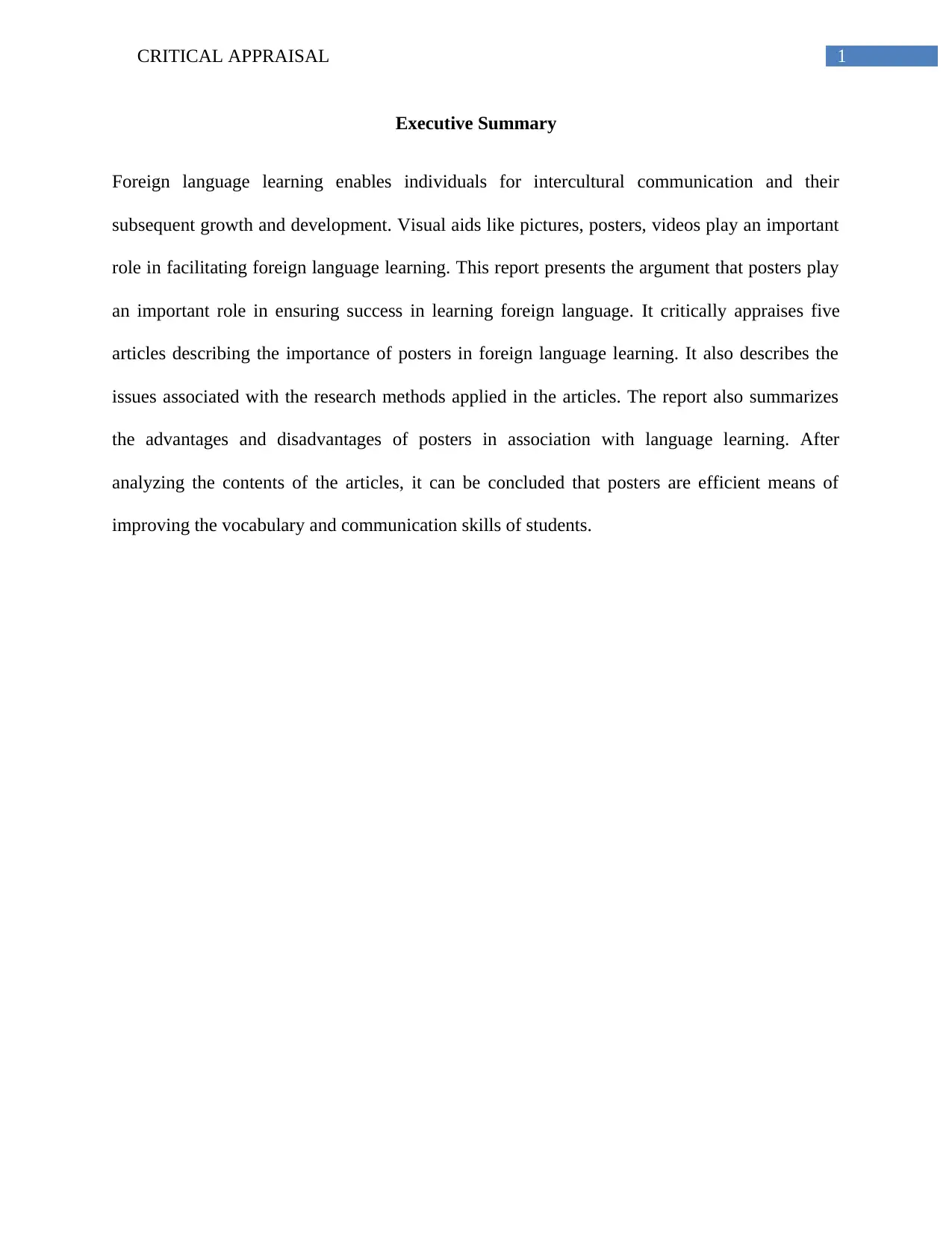
1CRITICAL APPRAISAL
Executive Summary
Foreign language learning enables individuals for intercultural communication and their
subsequent growth and development. Visual aids like pictures, posters, videos play an important
role in facilitating foreign language learning. This report presents the argument that posters play
an important role in ensuring success in learning foreign language. It critically appraises five
articles describing the importance of posters in foreign language learning. It also describes the
issues associated with the research methods applied in the articles. The report also summarizes
the advantages and disadvantages of posters in association with language learning. After
analyzing the contents of the articles, it can be concluded that posters are efficient means of
improving the vocabulary and communication skills of students.
Executive Summary
Foreign language learning enables individuals for intercultural communication and their
subsequent growth and development. Visual aids like pictures, posters, videos play an important
role in facilitating foreign language learning. This report presents the argument that posters play
an important role in ensuring success in learning foreign language. It critically appraises five
articles describing the importance of posters in foreign language learning. It also describes the
issues associated with the research methods applied in the articles. The report also summarizes
the advantages and disadvantages of posters in association with language learning. After
analyzing the contents of the articles, it can be concluded that posters are efficient means of
improving the vocabulary and communication skills of students.
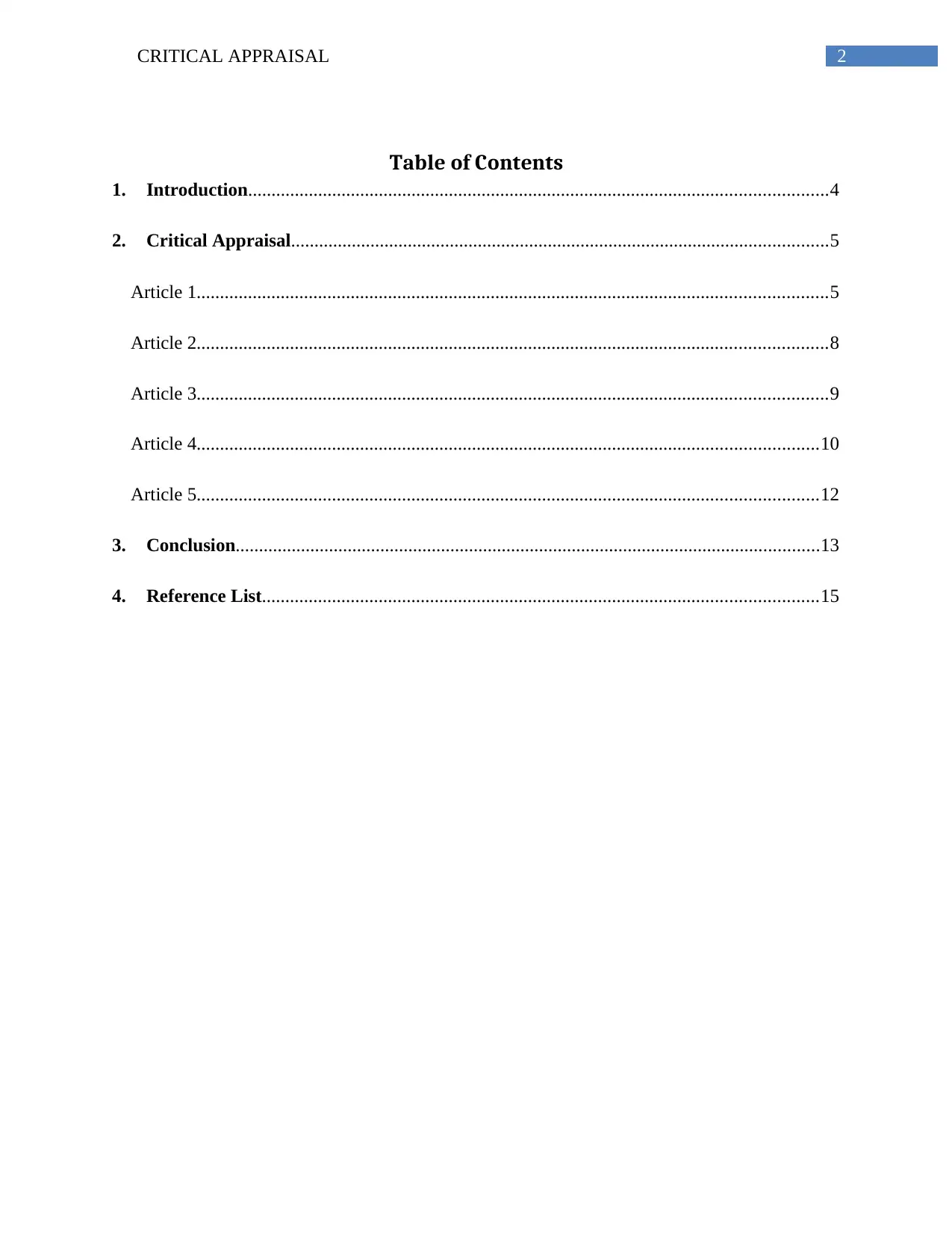
2CRITICAL APPRAISAL
Table of Contents
1. Introduction............................................................................................................................4
2. Critical Appraisal...................................................................................................................5
Article 1.......................................................................................................................................5
Article 2.......................................................................................................................................8
Article 3.......................................................................................................................................9
Article 4.....................................................................................................................................10
Article 5.....................................................................................................................................12
3. Conclusion.............................................................................................................................13
4. Reference List.......................................................................................................................15
Table of Contents
1. Introduction............................................................................................................................4
2. Critical Appraisal...................................................................................................................5
Article 1.......................................................................................................................................5
Article 2.......................................................................................................................................8
Article 3.......................................................................................................................................9
Article 4.....................................................................................................................................10
Article 5.....................................................................................................................................12
3. Conclusion.............................................................................................................................13
4. Reference List.......................................................................................................................15
⊘ This is a preview!⊘
Do you want full access?
Subscribe today to unlock all pages.

Trusted by 1+ million students worldwide
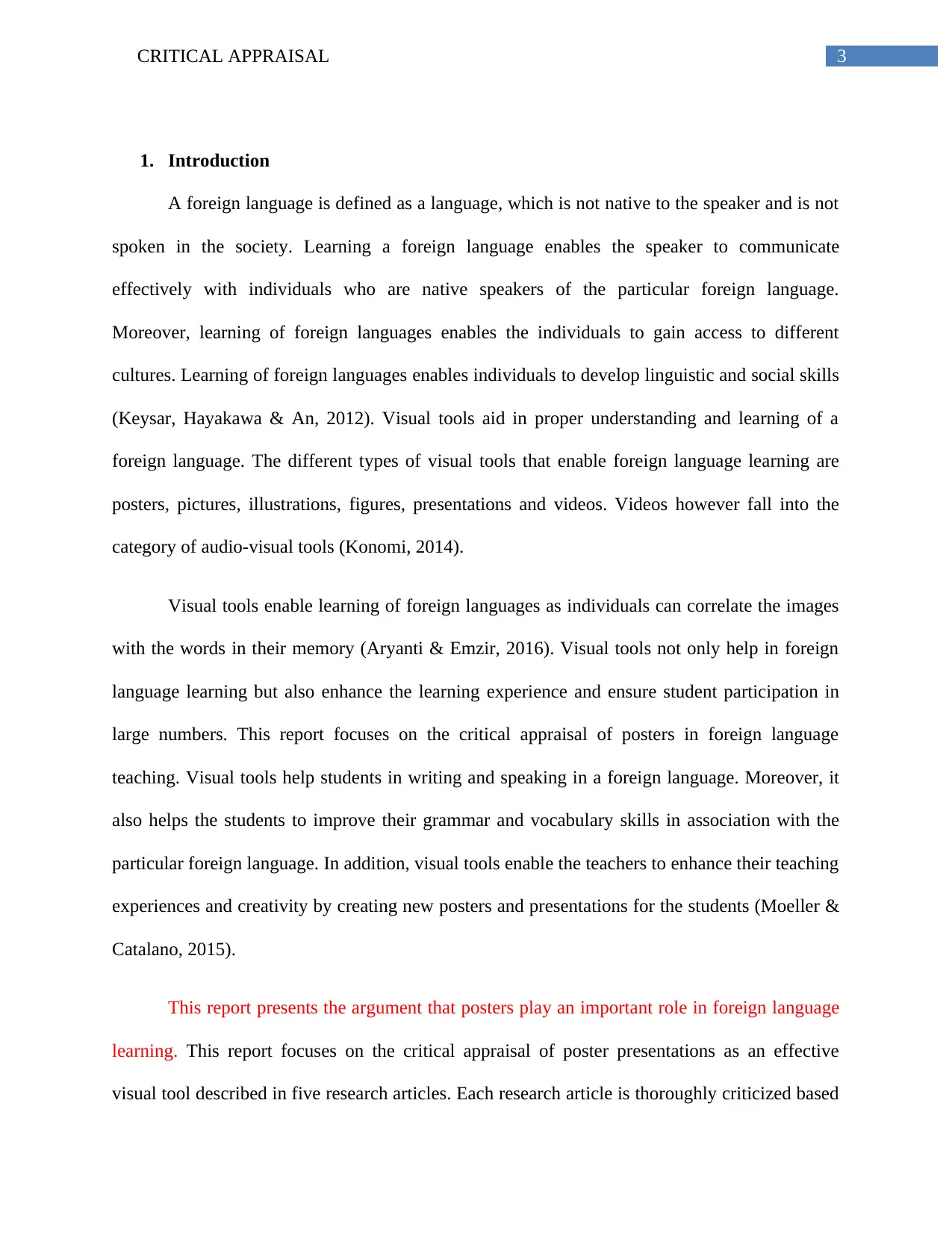
3CRITICAL APPRAISAL
1. Introduction
A foreign language is defined as a language, which is not native to the speaker and is not
spoken in the society. Learning a foreign language enables the speaker to communicate
effectively with individuals who are native speakers of the particular foreign language.
Moreover, learning of foreign languages enables the individuals to gain access to different
cultures. Learning of foreign languages enables individuals to develop linguistic and social skills
(Keysar, Hayakawa & An, 2012). Visual tools aid in proper understanding and learning of a
foreign language. The different types of visual tools that enable foreign language learning are
posters, pictures, illustrations, figures, presentations and videos. Videos however fall into the
category of audio-visual tools (Konomi, 2014).
Visual tools enable learning of foreign languages as individuals can correlate the images
with the words in their memory (Aryanti & Emzir, 2016). Visual tools not only help in foreign
language learning but also enhance the learning experience and ensure student participation in
large numbers. This report focuses on the critical appraisal of posters in foreign language
teaching. Visual tools help students in writing and speaking in a foreign language. Moreover, it
also helps the students to improve their grammar and vocabulary skills in association with the
particular foreign language. In addition, visual tools enable the teachers to enhance their teaching
experiences and creativity by creating new posters and presentations for the students (Moeller &
Catalano, 2015).
This report presents the argument that posters play an important role in foreign language
learning. This report focuses on the critical appraisal of poster presentations as an effective
visual tool described in five research articles. Each research article is thoroughly criticized based
1. Introduction
A foreign language is defined as a language, which is not native to the speaker and is not
spoken in the society. Learning a foreign language enables the speaker to communicate
effectively with individuals who are native speakers of the particular foreign language.
Moreover, learning of foreign languages enables the individuals to gain access to different
cultures. Learning of foreign languages enables individuals to develop linguistic and social skills
(Keysar, Hayakawa & An, 2012). Visual tools aid in proper understanding and learning of a
foreign language. The different types of visual tools that enable foreign language learning are
posters, pictures, illustrations, figures, presentations and videos. Videos however fall into the
category of audio-visual tools (Konomi, 2014).
Visual tools enable learning of foreign languages as individuals can correlate the images
with the words in their memory (Aryanti & Emzir, 2016). Visual tools not only help in foreign
language learning but also enhance the learning experience and ensure student participation in
large numbers. This report focuses on the critical appraisal of posters in foreign language
teaching. Visual tools help students in writing and speaking in a foreign language. Moreover, it
also helps the students to improve their grammar and vocabulary skills in association with the
particular foreign language. In addition, visual tools enable the teachers to enhance their teaching
experiences and creativity by creating new posters and presentations for the students (Moeller &
Catalano, 2015).
This report presents the argument that posters play an important role in foreign language
learning. This report focuses on the critical appraisal of poster presentations as an effective
visual tool described in five research articles. Each research article is thoroughly criticized based
Paraphrase This Document
Need a fresh take? Get an instant paraphrase of this document with our AI Paraphraser
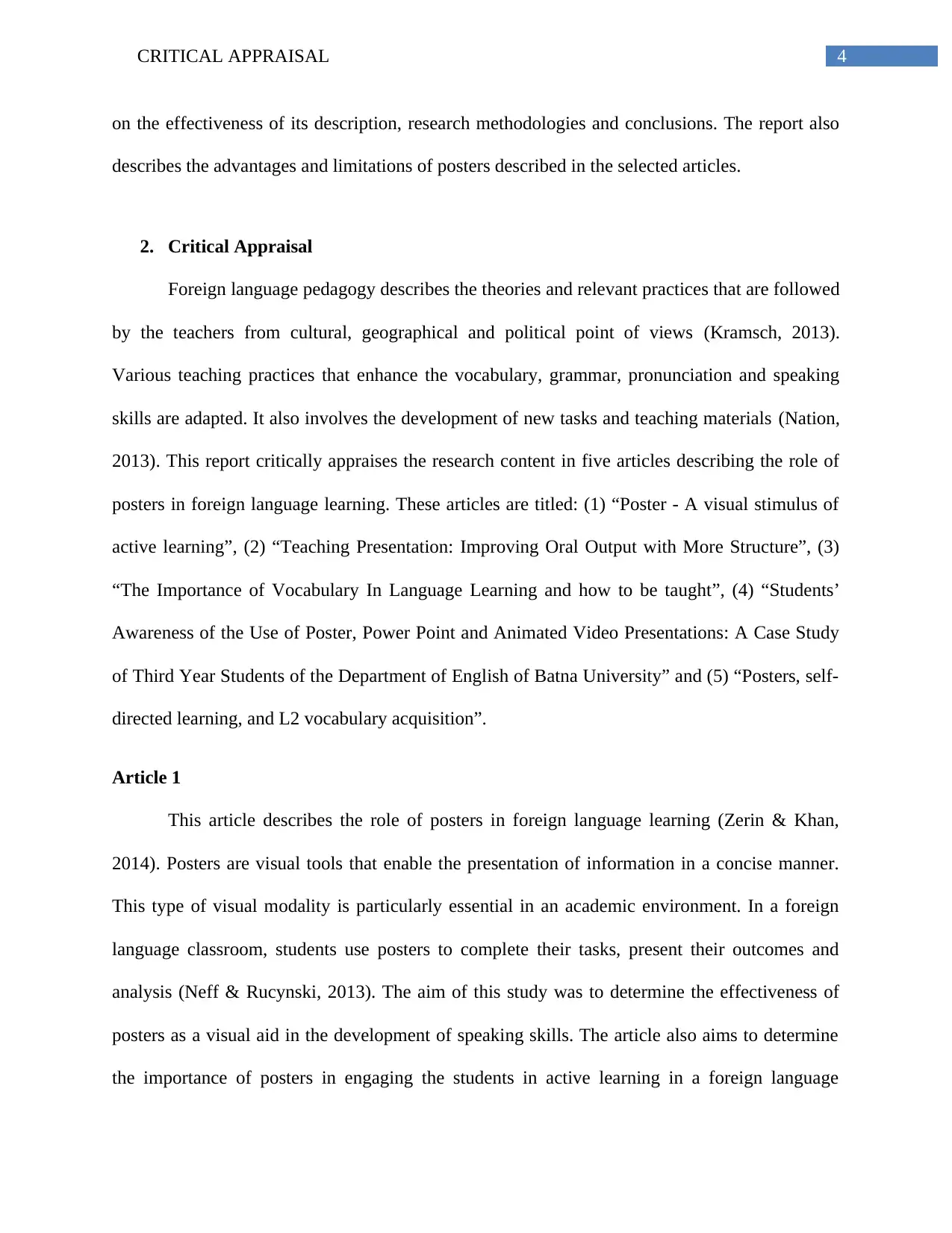
4CRITICAL APPRAISAL
on the effectiveness of its description, research methodologies and conclusions. The report also
describes the advantages and limitations of posters described in the selected articles.
2. Critical Appraisal
Foreign language pedagogy describes the theories and relevant practices that are followed
by the teachers from cultural, geographical and political point of views (Kramsch, 2013).
Various teaching practices that enhance the vocabulary, grammar, pronunciation and speaking
skills are adapted. It also involves the development of new tasks and teaching materials (Nation,
2013). This report critically appraises the research content in five articles describing the role of
posters in foreign language learning. These articles are titled: (1) “Poster - A visual stimulus of
active learning”, (2) “Teaching Presentation: Improving Oral Output with More Structure”, (3)
“The Importance of Vocabulary In Language Learning and how to be taught”, (4) “Students’
Awareness of the Use of Poster, Power Point and Animated Video Presentations: A Case Study
of Third Year Students of the Department of English of Batna University” and (5) “Posters, self-
directed learning, and L2 vocabulary acquisition”.
Article 1
This article describes the role of posters in foreign language learning (Zerin & Khan,
2014). Posters are visual tools that enable the presentation of information in a concise manner.
This type of visual modality is particularly essential in an academic environment. In a foreign
language classroom, students use posters to complete their tasks, present their outcomes and
analysis (Neff & Rucynski, 2013). The aim of this study was to determine the effectiveness of
posters as a visual aid in the development of speaking skills. The article also aims to determine
the importance of posters in engaging the students in active learning in a foreign language
on the effectiveness of its description, research methodologies and conclusions. The report also
describes the advantages and limitations of posters described in the selected articles.
2. Critical Appraisal
Foreign language pedagogy describes the theories and relevant practices that are followed
by the teachers from cultural, geographical and political point of views (Kramsch, 2013).
Various teaching practices that enhance the vocabulary, grammar, pronunciation and speaking
skills are adapted. It also involves the development of new tasks and teaching materials (Nation,
2013). This report critically appraises the research content in five articles describing the role of
posters in foreign language learning. These articles are titled: (1) “Poster - A visual stimulus of
active learning”, (2) “Teaching Presentation: Improving Oral Output with More Structure”, (3)
“The Importance of Vocabulary In Language Learning and how to be taught”, (4) “Students’
Awareness of the Use of Poster, Power Point and Animated Video Presentations: A Case Study
of Third Year Students of the Department of English of Batna University” and (5) “Posters, self-
directed learning, and L2 vocabulary acquisition”.
Article 1
This article describes the role of posters in foreign language learning (Zerin & Khan,
2014). Posters are visual tools that enable the presentation of information in a concise manner.
This type of visual modality is particularly essential in an academic environment. In a foreign
language classroom, students use posters to complete their tasks, present their outcomes and
analysis (Neff & Rucynski, 2013). The aim of this study was to determine the effectiveness of
posters as a visual aid in the development of speaking skills. The article also aims to determine
the importance of posters in engaging the students in active learning in a foreign language
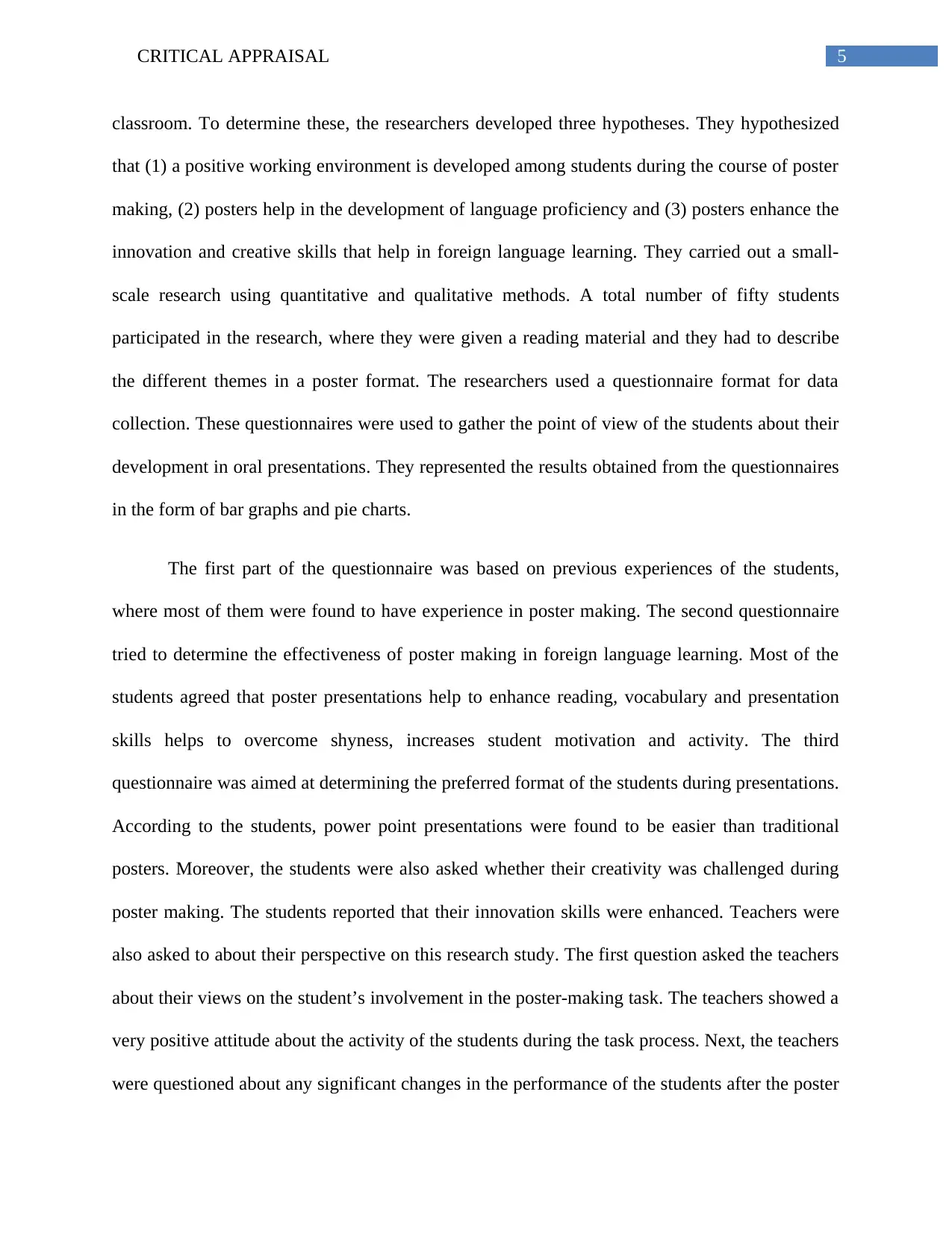
5CRITICAL APPRAISAL
classroom. To determine these, the researchers developed three hypotheses. They hypothesized
that (1) a positive working environment is developed among students during the course of poster
making, (2) posters help in the development of language proficiency and (3) posters enhance the
innovation and creative skills that help in foreign language learning. They carried out a small-
scale research using quantitative and qualitative methods. A total number of fifty students
participated in the research, where they were given a reading material and they had to describe
the different themes in a poster format. The researchers used a questionnaire format for data
collection. These questionnaires were used to gather the point of view of the students about their
development in oral presentations. They represented the results obtained from the questionnaires
in the form of bar graphs and pie charts.
The first part of the questionnaire was based on previous experiences of the students,
where most of them were found to have experience in poster making. The second questionnaire
tried to determine the effectiveness of poster making in foreign language learning. Most of the
students agreed that poster presentations help to enhance reading, vocabulary and presentation
skills helps to overcome shyness, increases student motivation and activity. The third
questionnaire was aimed at determining the preferred format of the students during presentations.
According to the students, power point presentations were found to be easier than traditional
posters. Moreover, the students were also asked whether their creativity was challenged during
poster making. The students reported that their innovation skills were enhanced. Teachers were
also asked to about their perspective on this research study. The first question asked the teachers
about their views on the student’s involvement in the poster-making task. The teachers showed a
very positive attitude about the activity of the students during the task process. Next, the teachers
were questioned about any significant changes in the performance of the students after the poster
classroom. To determine these, the researchers developed three hypotheses. They hypothesized
that (1) a positive working environment is developed among students during the course of poster
making, (2) posters help in the development of language proficiency and (3) posters enhance the
innovation and creative skills that help in foreign language learning. They carried out a small-
scale research using quantitative and qualitative methods. A total number of fifty students
participated in the research, where they were given a reading material and they had to describe
the different themes in a poster format. The researchers used a questionnaire format for data
collection. These questionnaires were used to gather the point of view of the students about their
development in oral presentations. They represented the results obtained from the questionnaires
in the form of bar graphs and pie charts.
The first part of the questionnaire was based on previous experiences of the students,
where most of them were found to have experience in poster making. The second questionnaire
tried to determine the effectiveness of poster making in foreign language learning. Most of the
students agreed that poster presentations help to enhance reading, vocabulary and presentation
skills helps to overcome shyness, increases student motivation and activity. The third
questionnaire was aimed at determining the preferred format of the students during presentations.
According to the students, power point presentations were found to be easier than traditional
posters. Moreover, the students were also asked whether their creativity was challenged during
poster making. The students reported that their innovation skills were enhanced. Teachers were
also asked to about their perspective on this research study. The first question asked the teachers
about their views on the student’s involvement in the poster-making task. The teachers showed a
very positive attitude about the activity of the students during the task process. Next, the teachers
were questioned about any significant changes in the performance of the students after the poster
⊘ This is a preview!⊘
Do you want full access?
Subscribe today to unlock all pages.

Trusted by 1+ million students worldwide
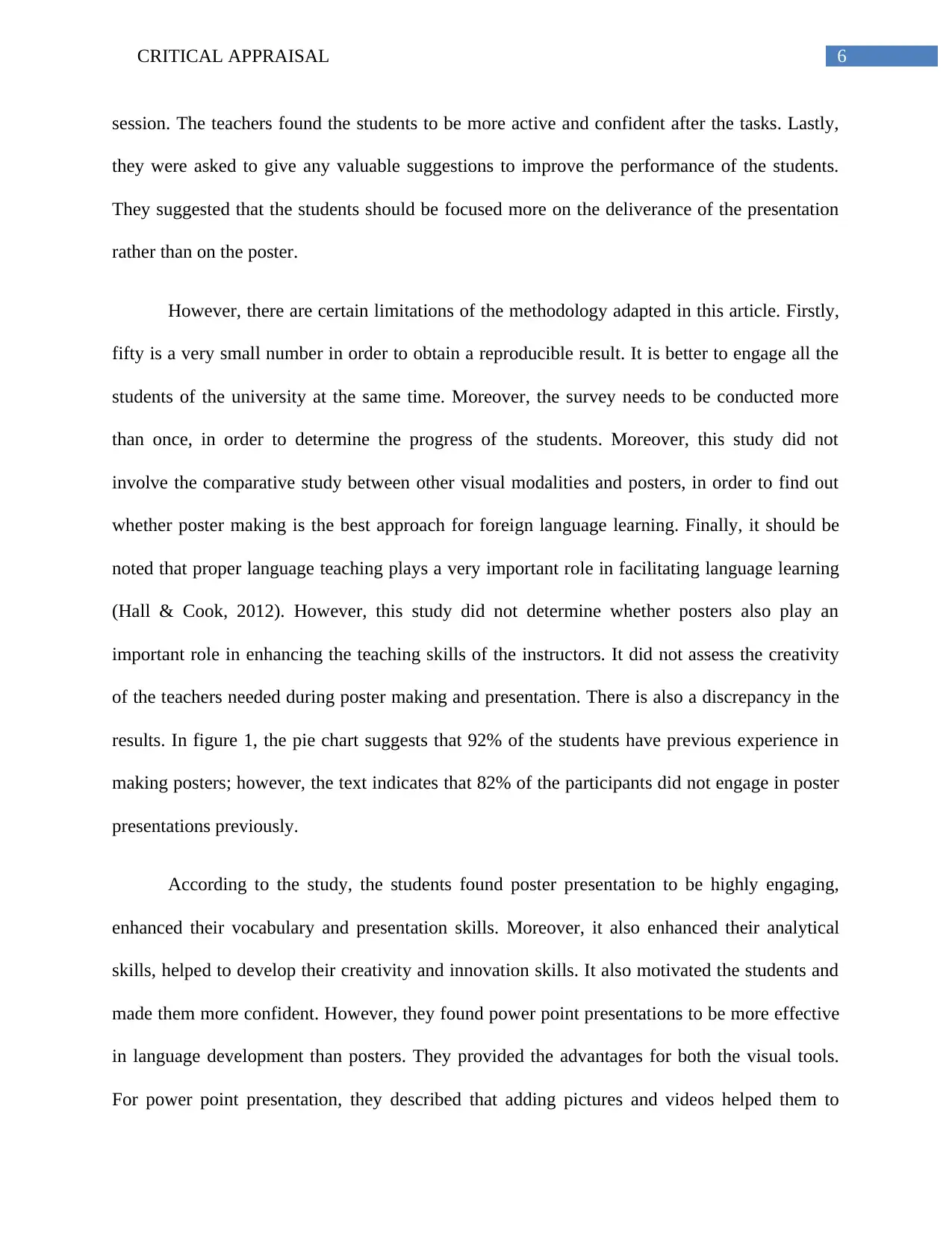
6CRITICAL APPRAISAL
session. The teachers found the students to be more active and confident after the tasks. Lastly,
they were asked to give any valuable suggestions to improve the performance of the students.
They suggested that the students should be focused more on the deliverance of the presentation
rather than on the poster.
However, there are certain limitations of the methodology adapted in this article. Firstly,
fifty is a very small number in order to obtain a reproducible result. It is better to engage all the
students of the university at the same time. Moreover, the survey needs to be conducted more
than once, in order to determine the progress of the students. Moreover, this study did not
involve the comparative study between other visual modalities and posters, in order to find out
whether poster making is the best approach for foreign language learning. Finally, it should be
noted that proper language teaching plays a very important role in facilitating language learning
(Hall & Cook, 2012). However, this study did not determine whether posters also play an
important role in enhancing the teaching skills of the instructors. It did not assess the creativity
of the teachers needed during poster making and presentation. There is also a discrepancy in the
results. In figure 1, the pie chart suggests that 92% of the students have previous experience in
making posters; however, the text indicates that 82% of the participants did not engage in poster
presentations previously.
According to the study, the students found poster presentation to be highly engaging,
enhanced their vocabulary and presentation skills. Moreover, it also enhanced their analytical
skills, helped to develop their creativity and innovation skills. It also motivated the students and
made them more confident. However, they found power point presentations to be more effective
in language development than posters. They provided the advantages for both the visual tools.
For power point presentation, they described that adding pictures and videos helped them to
session. The teachers found the students to be more active and confident after the tasks. Lastly,
they were asked to give any valuable suggestions to improve the performance of the students.
They suggested that the students should be focused more on the deliverance of the presentation
rather than on the poster.
However, there are certain limitations of the methodology adapted in this article. Firstly,
fifty is a very small number in order to obtain a reproducible result. It is better to engage all the
students of the university at the same time. Moreover, the survey needs to be conducted more
than once, in order to determine the progress of the students. Moreover, this study did not
involve the comparative study between other visual modalities and posters, in order to find out
whether poster making is the best approach for foreign language learning. Finally, it should be
noted that proper language teaching plays a very important role in facilitating language learning
(Hall & Cook, 2012). However, this study did not determine whether posters also play an
important role in enhancing the teaching skills of the instructors. It did not assess the creativity
of the teachers needed during poster making and presentation. There is also a discrepancy in the
results. In figure 1, the pie chart suggests that 92% of the students have previous experience in
making posters; however, the text indicates that 82% of the participants did not engage in poster
presentations previously.
According to the study, the students found poster presentation to be highly engaging,
enhanced their vocabulary and presentation skills. Moreover, it also enhanced their analytical
skills, helped to develop their creativity and innovation skills. It also motivated the students and
made them more confident. However, they found power point presentations to be more effective
in language development than posters. They provided the advantages for both the visual tools.
For power point presentation, they described that adding pictures and videos helped them to
Paraphrase This Document
Need a fresh take? Get an instant paraphrase of this document with our AI Paraphraser
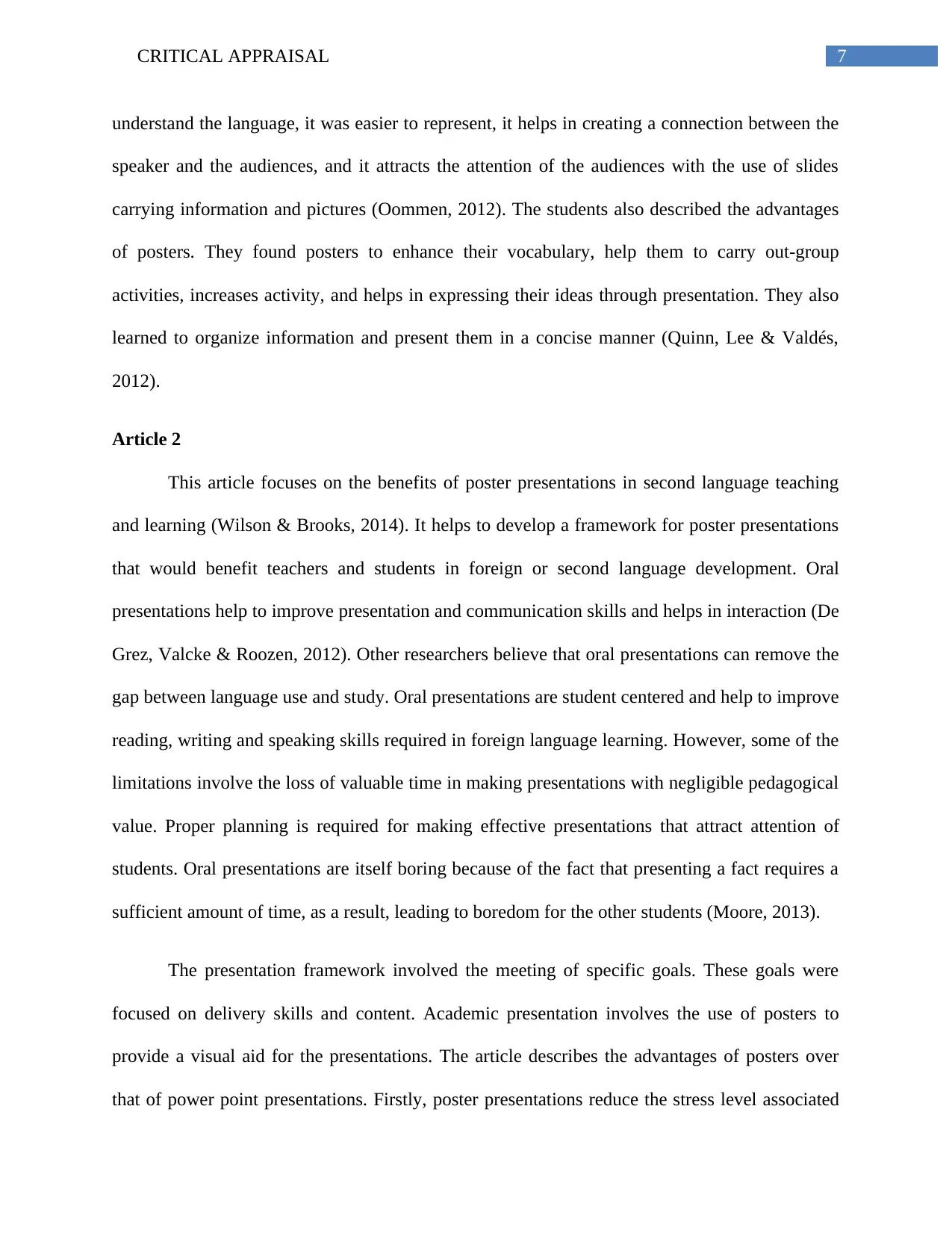
7CRITICAL APPRAISAL
understand the language, it was easier to represent, it helps in creating a connection between the
speaker and the audiences, and it attracts the attention of the audiences with the use of slides
carrying information and pictures (Oommen, 2012). The students also described the advantages
of posters. They found posters to enhance their vocabulary, help them to carry out-group
activities, increases activity, and helps in expressing their ideas through presentation. They also
learned to organize information and present them in a concise manner (Quinn, Lee & Valdés,
2012).
Article 2
This article focuses on the benefits of poster presentations in second language teaching
and learning (Wilson & Brooks, 2014). It helps to develop a framework for poster presentations
that would benefit teachers and students in foreign or second language development. Oral
presentations help to improve presentation and communication skills and helps in interaction (De
Grez, Valcke & Roozen, 2012). Other researchers believe that oral presentations can remove the
gap between language use and study. Oral presentations are student centered and help to improve
reading, writing and speaking skills required in foreign language learning. However, some of the
limitations involve the loss of valuable time in making presentations with negligible pedagogical
value. Proper planning is required for making effective presentations that attract attention of
students. Oral presentations are itself boring because of the fact that presenting a fact requires a
sufficient amount of time, as a result, leading to boredom for the other students (Moore, 2013).
The presentation framework involved the meeting of specific goals. These goals were
focused on delivery skills and content. Academic presentation involves the use of posters to
provide a visual aid for the presentations. The article describes the advantages of posters over
that of power point presentations. Firstly, poster presentations reduce the stress level associated
understand the language, it was easier to represent, it helps in creating a connection between the
speaker and the audiences, and it attracts the attention of the audiences with the use of slides
carrying information and pictures (Oommen, 2012). The students also described the advantages
of posters. They found posters to enhance their vocabulary, help them to carry out-group
activities, increases activity, and helps in expressing their ideas through presentation. They also
learned to organize information and present them in a concise manner (Quinn, Lee & Valdés,
2012).
Article 2
This article focuses on the benefits of poster presentations in second language teaching
and learning (Wilson & Brooks, 2014). It helps to develop a framework for poster presentations
that would benefit teachers and students in foreign or second language development. Oral
presentations help to improve presentation and communication skills and helps in interaction (De
Grez, Valcke & Roozen, 2012). Other researchers believe that oral presentations can remove the
gap between language use and study. Oral presentations are student centered and help to improve
reading, writing and speaking skills required in foreign language learning. However, some of the
limitations involve the loss of valuable time in making presentations with negligible pedagogical
value. Proper planning is required for making effective presentations that attract attention of
students. Oral presentations are itself boring because of the fact that presenting a fact requires a
sufficient amount of time, as a result, leading to boredom for the other students (Moore, 2013).
The presentation framework involved the meeting of specific goals. These goals were
focused on delivery skills and content. Academic presentation involves the use of posters to
provide a visual aid for the presentations. The article describes the advantages of posters over
that of power point presentations. Firstly, poster presentations reduce the stress level associated
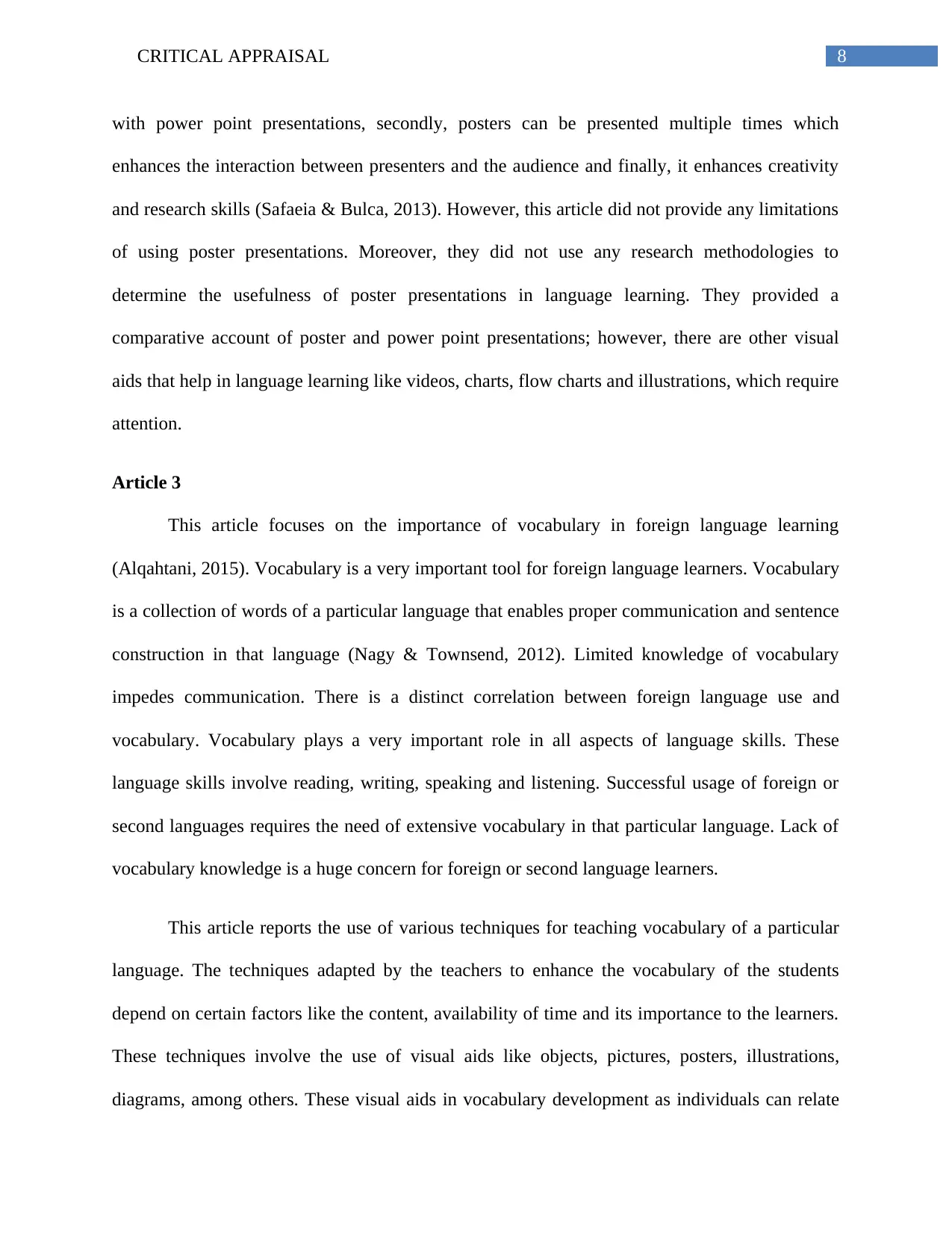
8CRITICAL APPRAISAL
with power point presentations, secondly, posters can be presented multiple times which
enhances the interaction between presenters and the audience and finally, it enhances creativity
and research skills (Safaeia & Bulca, 2013). However, this article did not provide any limitations
of using poster presentations. Moreover, they did not use any research methodologies to
determine the usefulness of poster presentations in language learning. They provided a
comparative account of poster and power point presentations; however, there are other visual
aids that help in language learning like videos, charts, flow charts and illustrations, which require
attention.
Article 3
This article focuses on the importance of vocabulary in foreign language learning
(Alqahtani, 2015). Vocabulary is a very important tool for foreign language learners. Vocabulary
is a collection of words of a particular language that enables proper communication and sentence
construction in that language (Nagy & Townsend, 2012). Limited knowledge of vocabulary
impedes communication. There is a distinct correlation between foreign language use and
vocabulary. Vocabulary plays a very important role in all aspects of language skills. These
language skills involve reading, writing, speaking and listening. Successful usage of foreign or
second languages requires the need of extensive vocabulary in that particular language. Lack of
vocabulary knowledge is a huge concern for foreign or second language learners.
This article reports the use of various techniques for teaching vocabulary of a particular
language. The techniques adapted by the teachers to enhance the vocabulary of the students
depend on certain factors like the content, availability of time and its importance to the learners.
These techniques involve the use of visual aids like objects, pictures, posters, illustrations,
diagrams, among others. These visual aids in vocabulary development as individuals can relate
with power point presentations, secondly, posters can be presented multiple times which
enhances the interaction between presenters and the audience and finally, it enhances creativity
and research skills (Safaeia & Bulca, 2013). However, this article did not provide any limitations
of using poster presentations. Moreover, they did not use any research methodologies to
determine the usefulness of poster presentations in language learning. They provided a
comparative account of poster and power point presentations; however, there are other visual
aids that help in language learning like videos, charts, flow charts and illustrations, which require
attention.
Article 3
This article focuses on the importance of vocabulary in foreign language learning
(Alqahtani, 2015). Vocabulary is a very important tool for foreign language learners. Vocabulary
is a collection of words of a particular language that enables proper communication and sentence
construction in that language (Nagy & Townsend, 2012). Limited knowledge of vocabulary
impedes communication. There is a distinct correlation between foreign language use and
vocabulary. Vocabulary plays a very important role in all aspects of language skills. These
language skills involve reading, writing, speaking and listening. Successful usage of foreign or
second languages requires the need of extensive vocabulary in that particular language. Lack of
vocabulary knowledge is a huge concern for foreign or second language learners.
This article reports the use of various techniques for teaching vocabulary of a particular
language. The techniques adapted by the teachers to enhance the vocabulary of the students
depend on certain factors like the content, availability of time and its importance to the learners.
These techniques involve the use of visual aids like objects, pictures, posters, illustrations,
diagrams, among others. These visual aids in vocabulary development as individuals can relate
⊘ This is a preview!⊘
Do you want full access?
Subscribe today to unlock all pages.

Trusted by 1+ million students worldwide
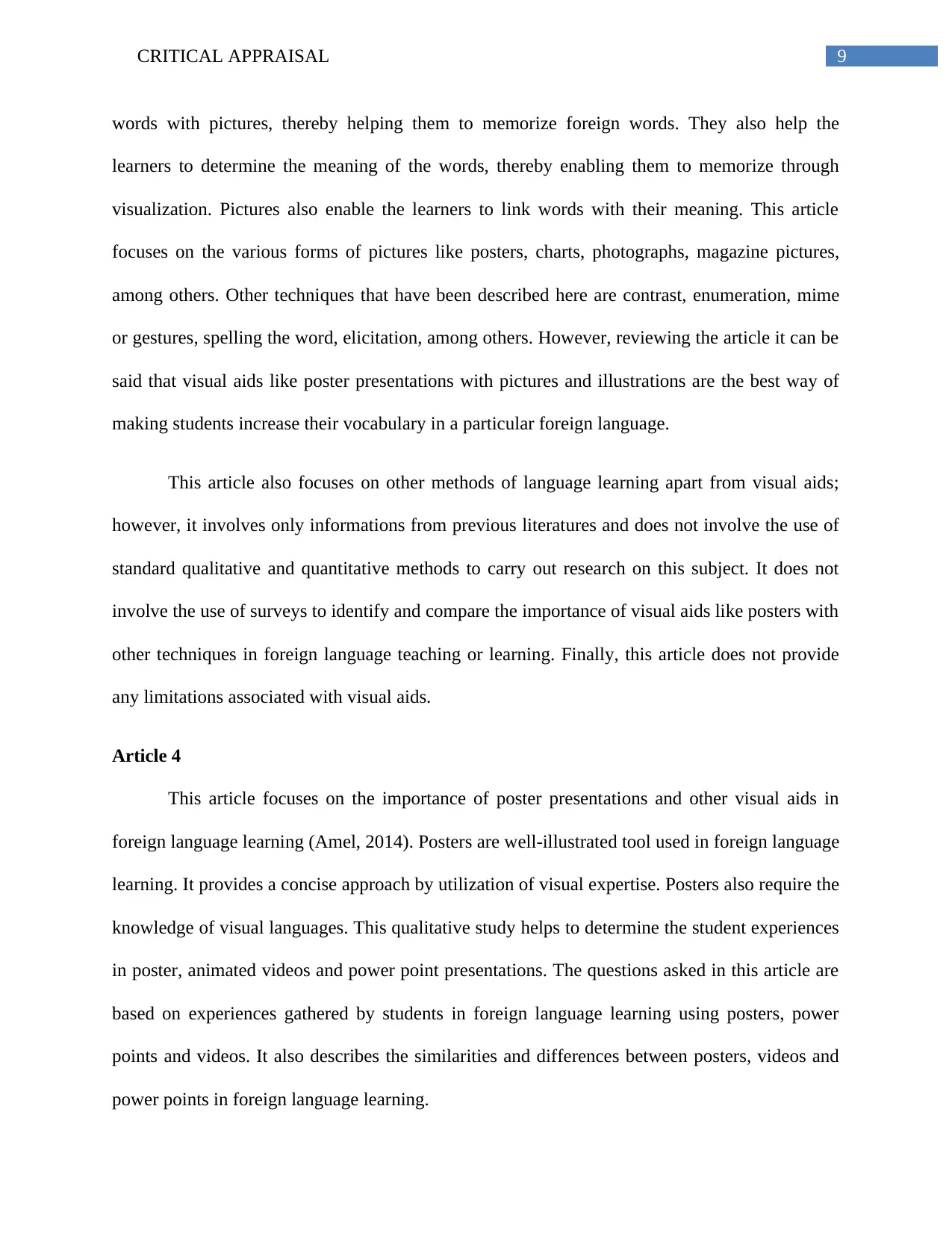
9CRITICAL APPRAISAL
words with pictures, thereby helping them to memorize foreign words. They also help the
learners to determine the meaning of the words, thereby enabling them to memorize through
visualization. Pictures also enable the learners to link words with their meaning. This article
focuses on the various forms of pictures like posters, charts, photographs, magazine pictures,
among others. Other techniques that have been described here are contrast, enumeration, mime
or gestures, spelling the word, elicitation, among others. However, reviewing the article it can be
said that visual aids like poster presentations with pictures and illustrations are the best way of
making students increase their vocabulary in a particular foreign language.
This article also focuses on other methods of language learning apart from visual aids;
however, it involves only informations from previous literatures and does not involve the use of
standard qualitative and quantitative methods to carry out research on this subject. It does not
involve the use of surveys to identify and compare the importance of visual aids like posters with
other techniques in foreign language teaching or learning. Finally, this article does not provide
any limitations associated with visual aids.
Article 4
This article focuses on the importance of poster presentations and other visual aids in
foreign language learning (Amel, 2014). Posters are well-illustrated tool used in foreign language
learning. It provides a concise approach by utilization of visual expertise. Posters also require the
knowledge of visual languages. This qualitative study helps to determine the student experiences
in poster, animated videos and power point presentations. The questions asked in this article are
based on experiences gathered by students in foreign language learning using posters, power
points and videos. It also describes the similarities and differences between posters, videos and
power points in foreign language learning.
words with pictures, thereby helping them to memorize foreign words. They also help the
learners to determine the meaning of the words, thereby enabling them to memorize through
visualization. Pictures also enable the learners to link words with their meaning. This article
focuses on the various forms of pictures like posters, charts, photographs, magazine pictures,
among others. Other techniques that have been described here are contrast, enumeration, mime
or gestures, spelling the word, elicitation, among others. However, reviewing the article it can be
said that visual aids like poster presentations with pictures and illustrations are the best way of
making students increase their vocabulary in a particular foreign language.
This article also focuses on other methods of language learning apart from visual aids;
however, it involves only informations from previous literatures and does not involve the use of
standard qualitative and quantitative methods to carry out research on this subject. It does not
involve the use of surveys to identify and compare the importance of visual aids like posters with
other techniques in foreign language teaching or learning. Finally, this article does not provide
any limitations associated with visual aids.
Article 4
This article focuses on the importance of poster presentations and other visual aids in
foreign language learning (Amel, 2014). Posters are well-illustrated tool used in foreign language
learning. It provides a concise approach by utilization of visual expertise. Posters also require the
knowledge of visual languages. This qualitative study helps to determine the student experiences
in poster, animated videos and power point presentations. The questions asked in this article are
based on experiences gathered by students in foreign language learning using posters, power
points and videos. It also describes the similarities and differences between posters, videos and
power points in foreign language learning.
Paraphrase This Document
Need a fresh take? Get an instant paraphrase of this document with our AI Paraphraser
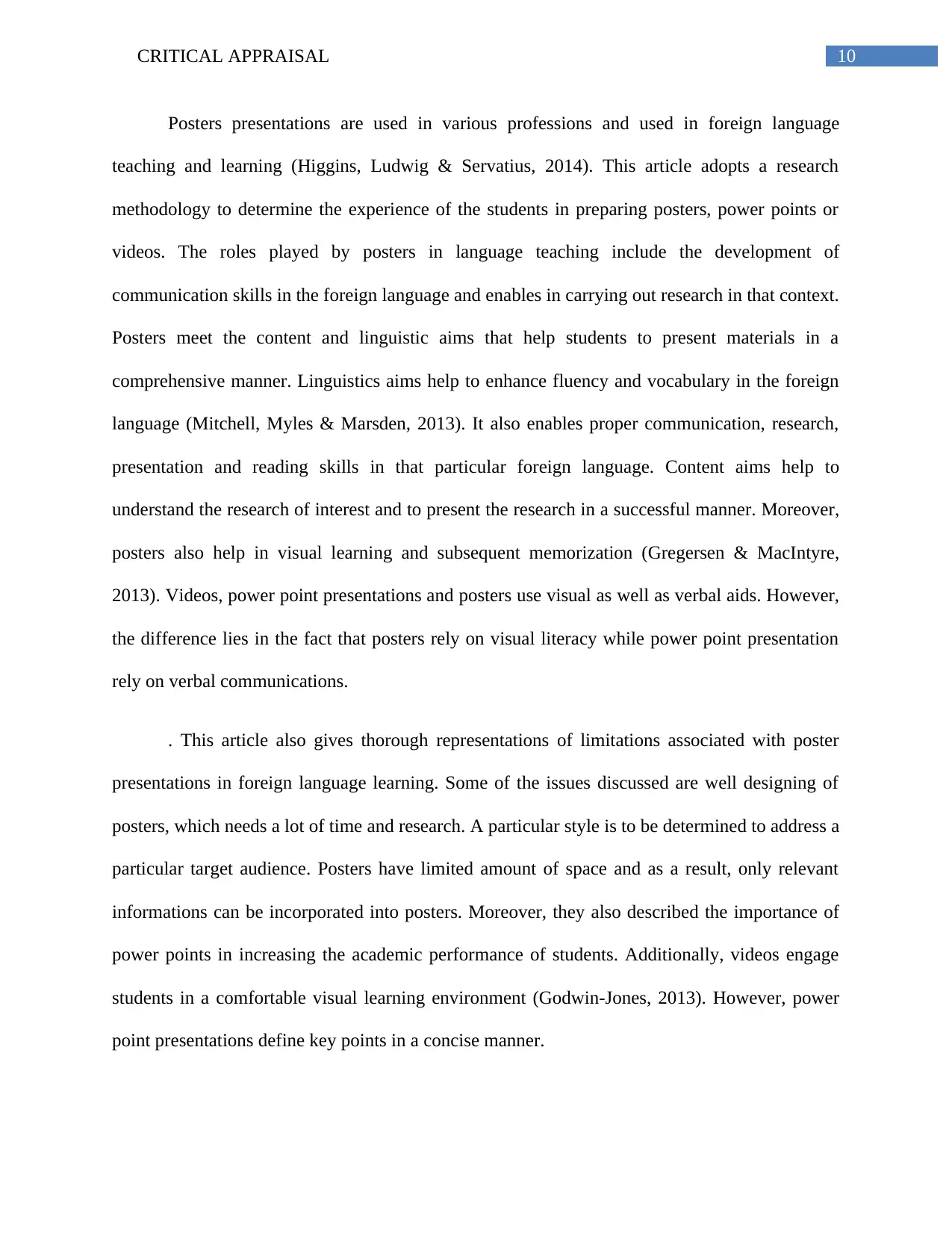
10CRITICAL APPRAISAL
Posters presentations are used in various professions and used in foreign language
teaching and learning (Higgins, Ludwig & Servatius, 2014). This article adopts a research
methodology to determine the experience of the students in preparing posters, power points or
videos. The roles played by posters in language teaching include the development of
communication skills in the foreign language and enables in carrying out research in that context.
Posters meet the content and linguistic aims that help students to present materials in a
comprehensive manner. Linguistics aims help to enhance fluency and vocabulary in the foreign
language (Mitchell, Myles & Marsden, 2013). It also enables proper communication, research,
presentation and reading skills in that particular foreign language. Content aims help to
understand the research of interest and to present the research in a successful manner. Moreover,
posters also help in visual learning and subsequent memorization (Gregersen & MacIntyre,
2013). Videos, power point presentations and posters use visual as well as verbal aids. However,
the difference lies in the fact that posters rely on visual literacy while power point presentation
rely on verbal communications.
. This article also gives thorough representations of limitations associated with poster
presentations in foreign language learning. Some of the issues discussed are well designing of
posters, which needs a lot of time and research. A particular style is to be determined to address a
particular target audience. Posters have limited amount of space and as a result, only relevant
informations can be incorporated into posters. Moreover, they also described the importance of
power points in increasing the academic performance of students. Additionally, videos engage
students in a comfortable visual learning environment (Godwin-Jones, 2013). However, power
point presentations define key points in a concise manner.
Posters presentations are used in various professions and used in foreign language
teaching and learning (Higgins, Ludwig & Servatius, 2014). This article adopts a research
methodology to determine the experience of the students in preparing posters, power points or
videos. The roles played by posters in language teaching include the development of
communication skills in the foreign language and enables in carrying out research in that context.
Posters meet the content and linguistic aims that help students to present materials in a
comprehensive manner. Linguistics aims help to enhance fluency and vocabulary in the foreign
language (Mitchell, Myles & Marsden, 2013). It also enables proper communication, research,
presentation and reading skills in that particular foreign language. Content aims help to
understand the research of interest and to present the research in a successful manner. Moreover,
posters also help in visual learning and subsequent memorization (Gregersen & MacIntyre,
2013). Videos, power point presentations and posters use visual as well as verbal aids. However,
the difference lies in the fact that posters rely on visual literacy while power point presentation
rely on verbal communications.
. This article also gives thorough representations of limitations associated with poster
presentations in foreign language learning. Some of the issues discussed are well designing of
posters, which needs a lot of time and research. A particular style is to be determined to address a
particular target audience. Posters have limited amount of space and as a result, only relevant
informations can be incorporated into posters. Moreover, they also described the importance of
power points in increasing the academic performance of students. Additionally, videos engage
students in a comfortable visual learning environment (Godwin-Jones, 2013). However, power
point presentations define key points in a concise manner.
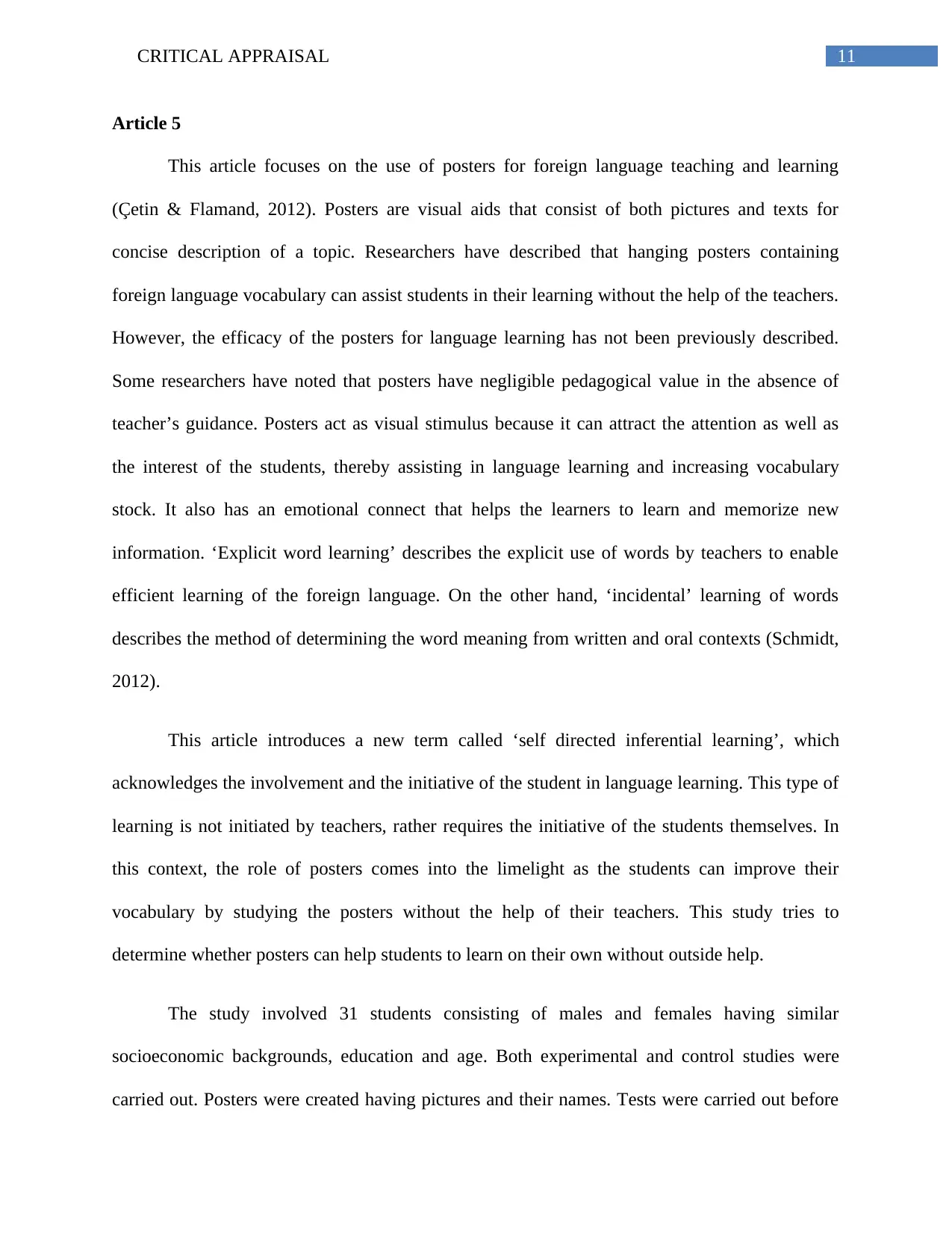
11CRITICAL APPRAISAL
Article 5
This article focuses on the use of posters for foreign language teaching and learning
(Çetin & Flamand, 2012). Posters are visual aids that consist of both pictures and texts for
concise description of a topic. Researchers have described that hanging posters containing
foreign language vocabulary can assist students in their learning without the help of the teachers.
However, the efficacy of the posters for language learning has not been previously described.
Some researchers have noted that posters have negligible pedagogical value in the absence of
teacher’s guidance. Posters act as visual stimulus because it can attract the attention as well as
the interest of the students, thereby assisting in language learning and increasing vocabulary
stock. It also has an emotional connect that helps the learners to learn and memorize new
information. ‘Explicit word learning’ describes the explicit use of words by teachers to enable
efficient learning of the foreign language. On the other hand, ‘incidental’ learning of words
describes the method of determining the word meaning from written and oral contexts (Schmidt,
2012).
This article introduces a new term called ‘self directed inferential learning’, which
acknowledges the involvement and the initiative of the student in language learning. This type of
learning is not initiated by teachers, rather requires the initiative of the students themselves. In
this context, the role of posters comes into the limelight as the students can improve their
vocabulary by studying the posters without the help of their teachers. This study tries to
determine whether posters can help students to learn on their own without outside help.
The study involved 31 students consisting of males and females having similar
socioeconomic backgrounds, education and age. Both experimental and control studies were
carried out. Posters were created having pictures and their names. Tests were carried out before
Article 5
This article focuses on the use of posters for foreign language teaching and learning
(Çetin & Flamand, 2012). Posters are visual aids that consist of both pictures and texts for
concise description of a topic. Researchers have described that hanging posters containing
foreign language vocabulary can assist students in their learning without the help of the teachers.
However, the efficacy of the posters for language learning has not been previously described.
Some researchers have noted that posters have negligible pedagogical value in the absence of
teacher’s guidance. Posters act as visual stimulus because it can attract the attention as well as
the interest of the students, thereby assisting in language learning and increasing vocabulary
stock. It also has an emotional connect that helps the learners to learn and memorize new
information. ‘Explicit word learning’ describes the explicit use of words by teachers to enable
efficient learning of the foreign language. On the other hand, ‘incidental’ learning of words
describes the method of determining the word meaning from written and oral contexts (Schmidt,
2012).
This article introduces a new term called ‘self directed inferential learning’, which
acknowledges the involvement and the initiative of the student in language learning. This type of
learning is not initiated by teachers, rather requires the initiative of the students themselves. In
this context, the role of posters comes into the limelight as the students can improve their
vocabulary by studying the posters without the help of their teachers. This study tries to
determine whether posters can help students to learn on their own without outside help.
The study involved 31 students consisting of males and females having similar
socioeconomic backgrounds, education and age. Both experimental and control studies were
carried out. Posters were created having pictures and their names. Tests were carried out before
⊘ This is a preview!⊘
Do you want full access?
Subscribe today to unlock all pages.

Trusted by 1+ million students worldwide
1 out of 17
Related Documents
Your All-in-One AI-Powered Toolkit for Academic Success.
+13062052269
info@desklib.com
Available 24*7 on WhatsApp / Email
![[object Object]](/_next/static/media/star-bottom.7253800d.svg)
Unlock your academic potential
Copyright © 2020–2025 A2Z Services. All Rights Reserved. Developed and managed by ZUCOL.





